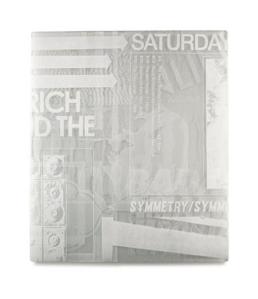
Katja Heller presented the work of Amber Cowan. Above: ROSETTE IN MILK AND IVORY, 2013, flameworked pressed and sheet glass/mixed media, 34 X 32 X 4 1/2 in; photo: Emma Salamon from Heller Gallery website
The panel discussion Graduated Glass: Perspectives on the Emerging Artist presented by Portland’s Bullseye Gallery, offered several useful takeaways for emerging artists in the field. Moderated by Bullseye Glass Co. Partner and Gallery Director Lani McGregor, the panel included Tina Oldknow, Curator at Corning Museum of Glass, Richard Whiteley, Glass Workshop Head at Canberra School of Art, Katja Heller, Director of Heller Gallery in New York, and Michael Endo, Curator at Bullseye Gallery.
The panel members each presented images of work by an emerging artist demonstrating the qualities they believe are important for a successful artistic career. (Lani McGregor’s pick was Stacy Lynn Smith, Michael Endo’s was Jennifer Halvorson, Katja Heller’s was Amber Cowan, Richard Whiteley’s was Brian Corr, and Tina Oldknow’s was Anna Mlasowsky.) Then, after a brief discussion on what it means to be an “emerging artist,” the they went on to discuss how they discover new artists, how emerging artists should promote themselves, and how collectors and patrons can support artists early in their careers.

Bullesye’s Michael Endo presented work by Jennifer Halvorson. Above: BOUNTY, 2013, cast glass, 5 x 10.5 x 7.5. Photo from Jennifer Halvorson’s website.
Rather than a detailed recap, here’s a bulleted list of useful information for artists:
- All the panelists selected conceptual work and stressed the idea that successful emerging artists today are selecting glass as a material because it best expresses the concept they are hoping to convey.
- Other important qualities, according to the panelists: well-developed thought process and individual voice; dedicated, even obsessive studio practice and research; finding new ways to be expressive with the material (inventive); and being willing to do whatever needs to be done to make work (dedication and resourcefulness).
- Most of the panelists suggested that graduate school is an important qualification for today’s emerging artists
- Galleries and curators follow an artist’s work for years, in some cases, before committing to a purchase or an exhibition. (So, keep working to build meaningful relationships with them. They are usually nice people anyway.)
- They look to New Glass Review, the Glass Art Society Student Exhibition, and Graduate program shows to discover new artists. They follow the recipients of important awards, fellowships, residents and teaching positions, and are often asked to serve as jury members in the selection process for these kinds of opportunities. (The REALLY IMPORTANT part of this point, is that you should KEEP APPLYING, even if you are initially rejected; they will take note of your work and how it grows over time.)
- Having a website is required. End of story. Well, not really. In my opinion, so is a Facebook page.They all want to know that you have it in you to continue making interesting work. A great quote from Katja Heller: “Anyone can make ONE good piece. I need to know they can be depended on to make another.”
- The panelists all acknowledged that there are more artists than there are opportunities, and that there is significant pressure to self-promote. There is a delicate balance to consider where this is concerned if working with galleries is your ultimate goal. Even when working with galleries, artists art being asked to do more than they have in the past to help promote their work to their own contacts and social media networks.
- Considering your big-picture goals, at least on a yearly basis, is important.
- Find a community. A Support group is vital. Also, work to support that community; invest time and energy in it. It often just takes one or two people to make interesting things happen.
- When asked what the biggest mistake an emerging artist can make, the unanimous answer of the panel was “giving up.”
